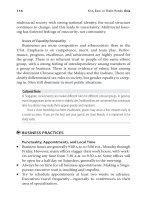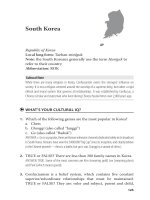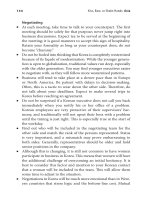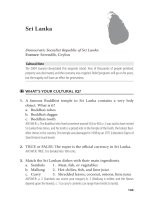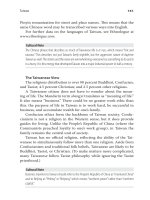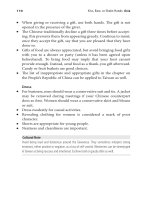KISS, BOW, OR SHAKE HANDS :How to Do Business in 12 Asian Countries ASIA pptx
Bạn đang xem bản rút gọn của tài liệu. Xem và tải ngay bản đầy đủ của tài liệu tại đây (2.55 MB, 256 trang )
KISS, BOW,
OR
SHAKE
HANDS:
ASIA
How to Do Business in
12 Asian Countries
• CULTURAL OVERVIEWS
• TIPS FOR DOING BUSINESS • KNOW BEFORE YOU GO
• NEGOTIATING STRATEGIES
• PROTOCOL
TERRI MORRISON AND WAYNE A. CONAWAY
ASIA
Terri Morrison, author of Kiss, Bow, or Shake Hands, 2nd Edition, resides in Newtown Square, PA and
is president of Getting Through Customs, a highly successful Internet product and training rm for
global business travelers. Her clients include American Airlines, AEP, Carnival Cruise Lines, Cypress
Semiconductor, Deloitte & Touche, Dun & Bradstreet, Hewlett-Packard, and Lucent Technologies. She
conducts seminars in intercultural communications, has written for many publications, has appeared
on numerous TV shows, and has been pro led and quoted in national newspapers and magazines
from the Wall Street Journal to Fortune.
$14.95 (Canada $19.95) Business
www.adamsmedia.com
The defi nitive guide to international
business and travel etiquette
“To help achieve success in communicating globally about
our business, there are critical tools never far from my reach:
my laptop or BlackBerry, my phone, and Terri Morrison’s
book Kiss, Bow, or Shake Hands.”
—Sherry Nebel, Vice President–Communications, Connexion by Boeing
Kiss, Bow, or Shake Hands: Asia reveals the subtleties of interaction, negotiation
strategies, and professional skills you need to keep poised for success in
your business travels. This comprehensive guide to Asia contains up-to-date
information to lead you through social situations, business meetings, and
understanding local culture.
Americans must now consider how economies are continuously shifting all
over Asia, and how Asian countries interact with the West and each other. Learn
about business practices, cognitive styles, and social customs. Give the right gift;
make the right gesture.
Countries pro led are China (and Hong Kong), India, Indonesia, Japan, Malaysia,
the Philippines, Singapore, South Korea, Sri Lanka, Taiwan, Thailand, and Vietnam.
Includes:
• Cultural IQ tests
• “Know Before You Go” tips
• Alerts on international security issues
MORRISON
and
CONAWAY
KISS, BOW,
OR
SHAKE HANDS:
KISS, BOW,
OR
SHAKE
HANDS:
ASIA
How to Do Business in
12 Asian Countries
• CULTURAL OVERVIEWS
• TIPS FOR DOING BUSINESS • KNOW BEFORE YOU GO
• NEGOTIATING STRATEGIES
• PROTOCOL
TERRI MORRISON AND WAYNE A. CONAWAY
Praise for the Kiss, Bow, or Shake Hands series
“In this global economy, ANYONE who leaves the U.S. is a fool if they don’t
read up on their destination’s customs. Kiss, Bow, or Shake Hands is THE
denitive authority on how to conduct yourself around the world. You can
easily oend your prospects and there is no faster way to kill the most lucra-
tive business deal. Kiss, Bow, or Shake Hands has been immeasurably helpful
over the years.”
—Louis Altman, President, New Hampshire International
Trade Association (NHITA), and President, GlobaFone
“Kiss, Bow, or Shake Hands has been an invaluable resource for international
businesspeople for years. Don’t leave home without it.”
—Joe Douress, Vice President,
LexisNexis Martindale-Hubbell
“Kiss, Bow, or Shake Hands is a great resource of cultural and business-
related information. e material is concise and easy to read. e cultural
information is unique, educational, and fun! It’s a book that can be enjoyed
by a great number of people, from a student, to a leisure traveler, to the most
sophisticated business person.”
—Joanna Savvides, President,
World Trade Center of Greater Philadelphia
“In my work, I train employees of multinational corporations on how to
manage the intercultural aspects of an international assignment. Kiss, Bow,
or Shake Hands is a tremendous resource for the growing number of indi-
viduals in today’s global workforce who nd themselves working across
international borders and on assignment outside their home country.”
—Carolyn Ryel, Senior Manager of Intercultural Services,
Cartus, Chicago, IL
“To help achieve success in communicating globally about our business,
there are critical tools never far from my reach: my laptop or BlackBerry, my
phone, and Terri Morrison’s Kiss, Bow, or Shake Hands.”
—Sherry Nebel, Vice President–Communications,
Connexion by Boeing
KISS, BOW,
OR
SHAKE
HANDS:
ASIA
How to Do Business in
12 Asian Countries
• CULTURAL OVERVIEWS
• TIPS FOR DOING BUSINESS • KNOW BEFORE YOU GO
• NEGOTIATING STRATEGIES
• PROTOCOL
T M W A. C
A, M
To Nica, Brendan, and Alex
Forever Wise, Forever True, Forever Loved
And to Tony
A chuisle mochroí
—T M
To my Parents
I hope I was a good long-term investment.
—W A. C
And to the late George A. Borden, Ph.D.,
a gied friend.
Copyright © 2007, Terri Morrison.
All rights reserved.
is book, or parts thereof, may not be reproduced
in any form without permission from the publisher;
exceptions are made for brief excerpts used in published reviews.
is book includes material previously published in Kiss, Bow, or Shake Hands by
Terri Morrison, © 2006, F+W Publications, Inc.
Published by Adams Media, an F+W Publications Company
57 Littleeld Street
Avon, MA 02322
www.adamsmedia.com
ISBN 10: 1-59869-216-X
ISBN 13: 978-1-59869-216-7 (paperback)
ISBN 13: 978-1-60550-852-8 (EPUB)
Printed in the United States of America.
J I H G F E D C B A
Library of Congress Cataloging-in-Publication Data
is available from publisher.
is publication is designed to provide accurate and authoritative information with
regard to the subject matter covered. It is sold with the understanding that the pub-
lisher is not engaged in rendering legal, accounting, or other professional advice. If
legal advice or other expert assistance is required, the services of a competent profes-
sional person should be sought.
—From a Declaration of Principles jointly adopted by a Committee of the
American Bar Association and a Committee of Publishers and Associations
Many of the designations used by manufacturers and sellers to distinguish their
product are claimed as trademarks. Where those designations appear in this book
and Adams Media was aware of a trademark claim, the designations have been
printed with initial capital letters.
Maps © Map Resouces.
is book is available at quantity discounts for bulk purchases.
For information, please call 1-800-289-0963.
v
Contents
vi Preface
viii Introduction
xi Cultural Orientation
xviii Map of Asia
1 China
16
Hong Kong
21 India
35 Indonesia
56 Japan
74 Malaysia
94 Philippines
110 Singapore
125 South Korea
143 Sri Lanka
155 Taiwan
171 ailand
183 Vietnam
197
Appendix A
Titles and Forms of Address in Asian Countries
202
Appendix B
Why Learn a Foreign Language?
205
Appendix C
Contacts and Resources
208
Appendix D
Avoiding Fashion Faux Pas
210
Appendix E
Holidays
212
Appendix F
Equivalents
216
Appendix G
International Electrical Adaptors
218 Index
221 About the Authors
vi
Preface
I since the rst edition of Kiss, Bow, or Shake
Hands was originally published, Asia has changed in remarkable
ways. Asian economies grew, collapsed, and recovered. e region
coped with epidemics, earthquakes, and tsunamis. Indonesia went
from one-party rule to democracy. Vietnam, once a pariah to the
USA and its allies, transformed itself into a valued trading partner.
India became the outsourcing capital of the world. e Soviet Union
dissolved, leaving its Central Asian republics to nd a new path alone.
Japan slowed, and China boomed. e interesting thing is that over
twelve years—throughout all of the massive political and economic
changes—the cultures, values, and belief systems of major ethnic
groups have remained constant.
For example, the former British Crown Colony of Hong Kong
was returned to China in 1997. Aer decades under British rule, the
businesspeople of Hong Kong had to adapt to the rules of the People’s
Republic of China. Many multinationals will grapple with the written
and unwritten rules of conduct in China as well (like Google, which
was temporarily censored by the Chinese government for several
days in 2006). Successful globalization will require that you, too,
learn how to adapt to the cultural aspects of doing business in Asia.
Just understanding Chinese name order and titles will give you an
advantage over other executives who do no research.
As Johann Wolfgang von Goethe said, “ere is nothing more
terrible than ignorance in action” (Es ist nichts schrecklicher als eine
tätige Unwissenheit).
During my life, I have seen World War, reconstruction, terror-
ism, and tremendous advances in technology. On this increasingly
interconnected planet, businesses need to acknowledge that people
are not alike all over the world—the more you respect local attitudes
toward families, work, and religion, the more successful you will be
in those locales. Priorities in Mumbai are not necessarily equivalent
to those in Milwaukee.
It is a pleasure to introduce you to this important book. Review
it before you embark on your international trips. Gain the informa-
tion you need on business practices, cognitive styles, negotiation
techniques, and social customs. Give the right gi; make the right
gesture. Read Kiss, Bow, or Shake Hands: Asia.
—H H.B. K,
the former Director of the Wharton Export Network
“e reputation of a thousand years
may be determined by the conduct of one hour.”
—J
Preface vii
viii
Introduction
W in 2010 or 2020 to work in Asia? As
Hans Koehler pointed out in his Preface, we live in changing times.
In this century China and India are changing the economic bal-
ance of the world. But many of the cultural tenets presented in Kiss,
Bow, or Shake Hands: Asia took hundreds or thousands of years to
develop. ese stable precepts help us understand why people behave
dierently around the world, and they will help you to avoid global
marketing faux pas like these:
McDonald’s Corporation settled a group of lawsuits for $10 million
in 2002. Why were they sued? Because of their French fries and hash
browns. Aer 1990, McDonald’s stated that only pure vegetable oil
was used to cook their fries, implying that they were prepared in a
“vegetarian” manner. However, the oil contained the essence of beef
avor, which is an anathema to Hindus and vegetarians worldwide.
Most of the money from the lawsuit was donated to Hindu and
other vegetarian causes.
Nike was forced to recall thousands of pairs of Air Bakin, Air BBQ,
Air Grill, and Air Melt shoes because of a decoration intended to
resemble re on the back of the sneakers. Unfortunately, when
viewed from right to le (which is the way Arabic is read), the
ames resembled the Arabic word for Allah. Muslims saw this as a
desecration on two levels: 1) the name of Allah may not be used on
a product, and 2) Arabic tradition deems that the foot is unclean.
Facing worldwide protests and boycotts, Nike implemented an
enormous recall of the expensive sneakers.
As these examples show, an unintentional misstep can threaten or
destroy your costly international marketing eorts. It also illustrates
the benets of learning the language of your target countries, and
corroborating translations and design elements locally.
Kiss, Bow, or Shake Hands: Asia is organized in a clear, consistent
manner to help you easily nd the data you need to avoid many of
the errors others have made before you.
e work to develop this volume resulted in not only this book,
but much additional information that is available on our Web site,
www.kissboworshakehands.com. e Web site also contains informa-
tion on ocial world holidays, recommendations for learning for-
eign languages, gi-giving suggestions, legal data, and hundreds of
articles like “Subtle Gestures,” and “Lie To Me.” Kiss, Bow is now part
of a larger electronic database—Kiss, Bow, or Shake Hands: Expanded
Edition. You are always welcome to contact us at 610-725-1040
or e-mail with your questions or
comments.
Each chapter in this book focuses on a single country, and all are
organized into sections, such as in the following example for China:
What’s Your Cultural IQ?
ree quick questions to gauge your knowledge
Tips on Doing Business in China
Five business-related highlights
Country Background
Demographics, History, Type of Government, Language, and
e Chinese View (perspectives from the country’s viewpoint)
Know Before You Go
Natural and human hazards
Cultural Orientation
A cultural anthropologist’s view. is section is described in detail
in an introductory chapter.
Business Practices
Punctuality, Appointments, and Local Time; Negotiating; Business
Entertaining
Introduction ix
x Kiss, Bow, or Shake Hands: Asia
Protocol
Greetings, Titles/Forms of Address, Gestures, Gis, and Dress
And many Cultural Notes on a variety of subjects are scattered
throughout the chapters.
(For more details on Titles/Forms of Address, Mailing Addresses,
etc., we recommend an excellent book called Merriam-Webster’s Guide
to International Business Communications, by Toby D. Atkinson.)
Please remember that you will work with individuals, and there
are always exceptions to every rule. For example, Kiss, Bow suggests
that many Japanese executives are reserved, polite, quiet, and rarely
display emotion. Somewhere there is probably a loud, boisterous,
gesticulating Japanese manager who is as emotional and imperious
as any prima donna. Just because we haven’t met him (or her) doesn’t
mean that no such person exists.
e process of communication is uid, not static. e success of
your intercultural interactions depends upon you and the quality of
your information. Kiss, Bow, or Shake Hands: Asia provides you with
the best and most current data possible on what foreign business and
social practices to expect in your eorts at globalization.
“Audi alteram partem.”
—Hear the other side.
xi
Cultural Orientation
F in Kiss, Bow, or Shake Hands: Asia
there is a Cultural Orientation section. e study of cultural orienta-
tion gives us a model for understanding and predicting the results
of intercultural encounters. It is, however, a model—a theory. New
discoveries continue to be made about why we act the way we do.
Furthermore, communication always takes place between indi-
viduals, not cultures. Few individuals are perfect representations of
their culture. Citizens of the United States of America are generally
known for addressing one another by rst names, a habit that most of
the world does not follow. However, there are many U.S. citizens who
are more comfortable with formality, and prefer to use last names
and titles. is does not make them any less like U.S. citizens. It just
makes them individuals.
Many global executives adopt the manners of their targeted coun-
tries, so why do U.S. executives need to study foreign ways? ere are
a variety of reasons.
First of all, many foreign businesspeople oen cannot or will not
imitate U.S. mannerisms. Can you aord to leave them out of your
business plans?
Second, you might wish to sell to the general public in a foreign
market. e average foreign consumer is certainly not going to
have the same habits or tastes as consumers in the United States of
America.
ird, although your business counterpart in Japan may act
or speak like an American or Canadian or Australian at times, he
isn’t. He probably is not even thinking in English; he is thinking in
Japanese. Knowing how Japanese people tend to arrive at decisions
gives you an edge. And don’t we all need every business advantage we
can get?
xii Kiss, Bow, or Shake Hands: Asia
Following the cultural orientation section, there is a breakdown
of the information contained therein.
Cognitive Styles: How We Organize
and Process Information
e word “cognitive” refers to thought, so “cognitive styles” refers to
thought patterns. We take in data every conscious moment. Some of
it is just noise, and we ignore it. Some of it is of no interest, and we
forget it as soon as we see/hear/feel/smell/taste it. Some data, how-
ever, we choose to accept.
Open-minded or Closed-minded?
Studies of cognitive styles suggest that people fall into open-
minded and closed-minded categories. e open-minded person seeks
out more information before making a decision. e closed-minded
person has tunnel vision—he or she sees only a narrow range of data
and ignores the rest.
Something that might surprise you is that most experts in cul-
tural orientation consider the citizens of the USA and Canada to be
closed-minded.
Open-minded people are more apt to see the relativity of issues.
ey admit that they don’t have all the answers, and that they need to
learn before they can come to a proper conclusion. Frankly, there are
not many cultures like that. Most cultures produce closed-minded
citizens.
Here’s an example: Most theocratic (governed by religious lead-
ers) cultures are closed-minded. at’s one of the characteristics of
such a culture: God tells you what is important. Anything outside of
those parameters can be ignored. From a business point of view, that
can be a weakness. For example, Islam prohibits charging interest on
a loan. ere can be no argument and no appeal: Charging interest is
wrong. Obviously, running a modern banking system without charg-
ing interest is challenging.
So why are Canada and the USA closed-minded?
Assume that someone from an Islamic country tells a North
American that the United States of America is evil and should become
a theocracy. e North American is likely to sco. e United States
a theocracy? Nonsense! Why, the separation of church and state is
one of the most sacred precepts established by the founding fathers
of the United States of America.
at North American is being closed-minded. He or she is refus-
ing to even consider the Muslim’s reasoning. A truly open-minded
person would consider the proposition. He or she might reject the
possibility aer due thought, but not without a complete evaluation.
In fact, a person who wants to study cultural orientation should
consider such questions. Granted, most businesspeople would prob-
ably decide that the United States of America should not become a
theocracy. But considering the topic can lead to some useful insights.
Perhaps most important is the concept that much of the world does
not share the United States’ predilection for the separation of church
and state. is separation is a specically Western notion, which
evolved out of the hundreds of years of European religious wars that
followed the Protestant Reformation.
In point of fact, most cultures tend to produce closed-minded
citizens as long as things are working fairly well. It oen takes a major
disaster to make people open-minded. For example, the citizens of
many former Communist nations are now becoming open-minded.
eir old Communist ideology has fallen apart, and they realize they
need new answers.
Associative or Abstractive Thinking?
Another aspect of cognitive styles is how people process infor-
mation. We divide such processing into associative and abstractive
characteristics.
A person who thinks associatively is ltering new data through
the screen of personal experience. New data (we’ll call it X) can only
be understood in relation to similar past experiences (Is this new
X more like A, or maybe B?). What if X is not like anything ever
encountered before? e associative thinker is still going to pigeon-
hole that new data in with something else (X is just another B). On
Cultural Orientation xiii
xiv Kiss, Bow, or Shake Hands: Asia
the other hand, the abstractive thinker can deal with something
genuinely new. When the abstractive person encounters new data,
he or she doesn’t have to lump it in with past experiences (It’s not
A, it’s not B or C—it’s new! It’s X!). e abstractive person is more
able to extrapolate data and consider hypothetical situations (“I’ve
never experienced X, but I’ve read about how such things might
occur”).
Obviously, no country has more than its share of smart (or dull)
people. However, some cultures have come to value abstractive think-
ing, whereas others encourage associative patterns. Much of this has
to do with the educational system. A system that teaches by rote
tends to produce associative thinkers. An educational system that
teaches problem-solving develops abstractive thinking. e scientic
method is very much a product of abstractive thinking. Both north-
ern Europe and North America produce a lot of abstractive thinkers.
Particular or Universal Thinking?
One nal category has to do with how thinking and behavior are
focused. People are divided into particular versus universal thinkers.
e particularistic person feels that a personal relationship is more
important than obeying rules or laws. On the other hand, the univer-
salistic person tends to obey regulations and laws; relationships are
less important than an individual’s duty to the company, society, and
authority in general.
Not surprisingly, the previous categories tend to go together in
certain patterns. Abstractive thinkers oen display universalistic
behavior: It requires abstractive thought to see beyond one’s personal
relationships and consider “the good of society” (which is a very
abstract concept).
Negotiation Strategies: What We Accept as Evidence
In general, let us assume that everyone acts on the basis of his or her
own best interests. e question becomes: How do I decide if this is a
good deal or not? Or, in a broader sense, what is the truth?
Dierent cultures arrive at truth in dierent ways. ese ways can
be distilled into faith, facts, and feelings.
e person who acts on the basis of faith is using a belief system,
which can be a religious or political ideology. For example, many
small nations believe in self-suciency. ey may reject a deal that
is overwhelmingly advantageous simply because they want their
own people to do it. It doesn’t matter that you can provide a better-
quality product at a much lower price; they believe it is better that
their fellow citizens produce the product, even if they produce an
inferior product at a higher cost. Presenting facts to such a person is
a waste of time. His or her faith operates independently from facts.
Clearly, people who believe in facts want to see evidence to sup-
port your position. ey can be the most predictable to work with. If
you oer the low bid, you get the job.
People who believe in feelings are the most common throughout
the world. ese are the people who “go with their gut instincts.”
ey need to like you in order to do business with you. It can take a
long time to build up a relationship with them. However, once that
relationship is established, it is very strong. ey aren’t going to run
to the rst company that undercuts your oer.
Value Systems: The Basis for Behavior
Each culture has a system for dividing right from wrong, or good
from evil. Aer a general statement concerning the values of the cul-
ture, this section identies the culture’s three value systems (Locus
of Decision-Making, Sources of Anxiety Reduction, and Issues of
Equality/Inequality). ese following three sections identify the
Value Systems in the predominant culture of each country.
Locus of Decision-Making
is section explores how much a culture prizes individualism as
opposed to collectivism. Some countries, such as the USA, are very
individualistic, while others, such as China, are very collectivistic.
A person in the United States may consider only himself or herself
Cultural Orientation xv
xvi Kiss, Bow, or Shake Hands: Asia
when making a decision, while a person in China must abide by the
consensus of the collective group.
Such pure individualism and collectivism is rare. In most coun-
tries people consider more than just themselves, but are not bound
by the desires of the group.
It is possible to consider the loci of decision-making as a series
of concentric circles. In the center, in the smallest circle, is the indi-
vidual. e next circle, slightly larger, is usually the family. Many
cultures expect each individual to consider “What is best for my
family?” prior to making any decisions. e next circle represents
a larger group. It could be an ethnic group, a religion, or even the
individual’s country. Some cultures expect individuals to consider
the best interests of the entire, expansive group.
Of course, when a person is acting as representative for a com-
pany, the best interests of the company may be paramount.
Sources of Anxiety Reduction
Every human being on this planet is subject to stress. How do we
handle it? How do we reduce anxiety?
We can identify four basic sources of security and stability that
people turn to: interpersonal relationships, religion, technology, and
the law. Frequently, a combination of sources is used.
A person who must decide on an important business deal is under
stress. If this person is your client, it may help you to know where he
or she will turn for help and advice. is is especially true when the
person turns to interpersonal relationships. If an executive is going
to ask his or her spouse for advice, you had better make sure that you
have made a good impression on that spouse.
Issues of Equality/Inequality
An important characteristic of all cultures is the division of
power. Who controls the government, and who controls the business
resources?
“All men are created equal” is a sacred tenet of the United States
of America. Despite this, prejudice against many groups still exists in
the United States.
All cultures have disadvantaged groups. is section identies
some sectors that have unequal status. ese can be dened by eco-
nomic status as well as by race or gender. Only the most industrial-
ized nations tend to have a large, stable middle class. Many countries
have a small, rich elite and a huge, poverty-stricken underclass.
Issues of male-female equality are also analyzed in this section.
It is useful for a female business executive to know how women are
regarded in a foreign country.
Never forget that this model represents cultural patterns that may
or may not apply to each individual you contact and get to know.
Utilize this information as a guideline and remain open to the new
experiences we all encounter abroad.
“Vérité en-deça des Pyrénées, erreur au-delà.”
—B P, –
“ere are truths on this side of the Pyrenees
which are falsehoods on the other.”
—: G H
Cultural Orientation xvii
xviii
China
PAGE 1
South Korea
PAGE 125
Japan
PAGE 56
India
PAGE 21
Thailand
PAGE 171
Mayaysia
PAGE 74
Singapore
PAGE 110
Indonesia
PAGE 35
Vietnam
PAGE 183
Sri Lanka
PAGE 143
Taiwan
PAGE 155
Philippines
PAGE 94
Hong Kong
PAGE 16
MAP OF ASIA
PAC I FI C OCE AN
Bay of B engal
Ara bia n Sea
I N DI A N O CE A N
South China
Sea
Philippine
Sea
Mongolia
Pakistan
Tibet
Nepal
Burma
Bangladesh
Laos
Cambodia
1
China
People’s Republic of China
Local short form: Zhong Guo
Local long form: Zhonghua Renmin Gongheguo
Abbreviation: PRC
Cultural Note
The People’s Republic of China is well on its way to becoming the superpower of the twenty-
first century. Aside from having the world’s largest population and the world’s largest army,
it is a nuclear and space power. Now it is a global economic power as well. In February of
2005, the government of China lent the government of Russia U.S. $6 billion to help Moscow
nationalize the oil company Yukos.
●
3
WHAT’S YOUR CULTURAL IQ?
1. TRUE or FALSE? e Chinese are not interested in most interna-
tional sports.
ANSWER: FALSE. While many Chinese have limited experience playing sports, they are often
avid fans (and sports gamblers). When Shanghai-born Yao Ming joined the Houston Rockets
in 2002, Chinese interest in basketball soared overnight. And the Beijing Olympics has gener-
ated massive interest in Olympic sports.
2. Match the following Nobel Prize laureates with the appropriate
prize:
a. Tenzin Gyatso 1. Nobel in physics, 1957
b. Chen Ning Yang 2. Nobel for literature, 2000
c. Gao Xingjian 3. Nobel Peace Prize, 1989
ANSWERS: a. 3; b. 1; c. 2. Tenzin Gyatso is better known as the fourteenth Dalai Lama of Tibet.
Tibet, of course, has been occupied by the PRC since 1950. Gao Xingjian was the first Chinese
to win the Nobel for literature. There have been many Nobel Prizes awarded to Chinese in
2 Kiss, Bow, or Shake Hands: Asia
the sciences, although most of the recipients (like Chen Ning Yang) have done their most
important scientific work in the West.
3. ere are many places in Asia where the People’s Republic of
China nds itself in conict with other countries. Which of these
is not currently an international “hot spot?”
a. Macao
b. North Korea
c. e Spratly Islands
d. Taiwan
ANSWER: a. Portugal ceded its colony of Macao to the PRC at the end of 1999, and Macao has
been relatively peaceful since then. A traditional site for gambling, Macao is the only place on
the Chinese mainland where casinos are permitted.
●
3
TIPS ON DOING BUSINESS IN CHINA
●
Experienced travelers avow that patience is the most important
skill needed to do business in China. e Chinese are very good
at guring out when a foreigner is under pressure from a tight
deadline, and they turn that to their advantage in negotiations.
●
Although the economic boom is changing things, China is still a
hierarchical society. Age is respected. When you send more than
one representative to China, the oldest person should receive
deference from the younger ones. e elder representative should
even enter and leave the conference room rst.
●
While the Chinese have made great strides in using the Inter-
net, they face serious obstacles. For one thing, the thousands of
ideographs in Chinese language are not easily adapted to use on
a computer keyboard. Also, Internet use in China is hampered by
the government, which censors Web sites and periodically shuts
down Internet cafés.
●
If possible, avoid traveling to China during the lunar New Year.
Also called Spring Festival, this is China’s most important, nation-
wide weeklong holiday. Tradition demands that every Chinese
return to his or her traditional home during the lunar New Year.
With so many migrants to the cities, this means that there are
millions of trips taken by car, bus, train, or airplane during the
festival.
Cultural Note
The lunar New Year puts enormous strains on China’s transportation infrastructure. Many
people wait for days just to secure standing room on a train or bus. To alleviate this, the
Chinese government is considering mandating staggered vacations, in the hope that travel
will be eased if not everyone is off work at the same time. This may ease travel during China’s
other national holidays, but it is doubtful whether it will eliminate the Spring Festival tradition
of returning to one’s ancestral home.
●
3
COUNTRY BACKGROUND
Demographics
China has 1.3 billion inhabitants (2006 estimate), making it the
most populous country in the world. One quarter of the earth’s
population lives there. Although there are many minority groups,
over 91 percent of the population is ethnic (Han) Chinese. China has
implemented a rigorous birth control program that limits couples to
only one child.
History
e Chinese boast the world’s oldest continuous civilization,
with more than 4,000 years of recorded history. Beijing (old Peking)
has been the capital of China for over 800 years and is the country’s
political, economic, and cultural hub.
China was ruled by strong dynasties for thousands of years. e
rst recorded dynasty, the Hsia, existed around 2200 .., and the last
dynasty, the Ch’ing, ended in 1911. Some of the most important cul-
tural achievements in history were produced during this time, such as
papermaking, the compass, gunpowder, and movable-type printing.
Aer the fall of the last dynasty, Sun Yat-sen founded the Republic
of China and was succeeded by Chiang Kai-shek in 1927.
Mao Tse-tung’s Communist forces took control in 1949 and estab-
lished the Communist government that still exists, although events—
China 3
4 Kiss, Bow, or Shake Hands: Asia
from the massacre in Tiananmen Square in June of 1989 on—have
shown an increasingly popular demand for democratic reform.
China has been divided into twenty-two provinces, ve autono-
mous regions, and three municipalities.
Type of Government
e People’s Republic of China has a Communist government.
ere is a single legislative house, the National People’s Congress;
all members belong to the Communist Party. e National People’s
Congress elects the Standing Committee, which holds executive
power and is made up of the premier and leading ministers. e pre-
mier is the head of the government; the president is the chief of state.
e position of secretary general of the Central Committee of the
Chinese Communist Party is also an oce of great power; it is oen
held by the current president.
e Communist regime is highly centralized and authoritarian,
and controls many aspects of life in China.
Current government data can be found at the Embassy of China
at www.china-embassy.org.
Cultural Note
The revolutionary government of the People’s Republic of China made changes to the Chinese
language. Many complex symbols in written Chinese were simplified. And the direction of
written Chinese was changed: instead of being written in vertical columns, it is now primarily
written like most Western tongues, from left to right in horizontal rows.
This reformed Chinese has not been universally accepted by the Chinese outside the PRC.
Some Taiwanese refuse to reform Chinese, preferring the pre-revolutionary forms. When you
go to the PRC, make sure your translators use reformed Chinese.
Language
e ocial national language is standard Chinese, based on the
Mandarin dialect. It is spoken by more than 70 percent of the popu-
lation. Many Chinese speak Cantonese, Shanghainese, and Kejia dia-
lects. Ethnologue, at www.ethnologue.com, recognizes 202 languages.
Each minority speaks its own dialect or language. English is spoken
by many businesspeople.
Although spoken Chinese has many dialects (some of which are
as dierent as English is from German) there is one common written
language. is is why many Chinese movies include Chinese sub-
titles, so that Cantonese-speaking Chinese audiences can understand
the Mandarin-speaking actors, or vice versa.
e government of the PRC has begun investing in Chinese lan-
guage training for foreigners. Contributions to support Chinese lan-
guage programs are being made to major trade partners worldwide.
Cultural Note
Of all its trading partners, China’s relationship with Japan is one of its most contradictory. The
government of the PRC is always ready to criticize Japan for any real or imagined offense, from
Japan’s cozy relationship with Taiwan to Japan’s failure to be properly abashed for its military
actions in China before and during the Second World War. Yet, in 2004, China surpassed the
USA as Japan’s largest trading partner. Their trade continues, despite such real conflicts as
both countries claiming the same offshore oil fields, or a Chinese submarine being detected in
Japanese waters in November of 2004.
The Chinese View
Despite the fact that the government encourages atheism, the
Chinese Constitution guarantees religious freedom (within certain
constraints). Buddhism, Islam, and Christianity are the three major
formal religions practiced in China. However, even larger numbers
of Chinese believe in traditional Chinese philosophies, notably Con-
fucianism and Taoism.
Confucianism, although not a religion with a divine deity, has
great inuence on Chinese society. Confucius was a Chinese scholar
and statesman who lived during feudal times over 2,000 years ago.
He established a rigid ethical and moral system that governs all
relationships.
Confucius taught that the basic unit of society is the family. In order
to preserve harmony in the home, certain reciprocal responsibilities
China 5



